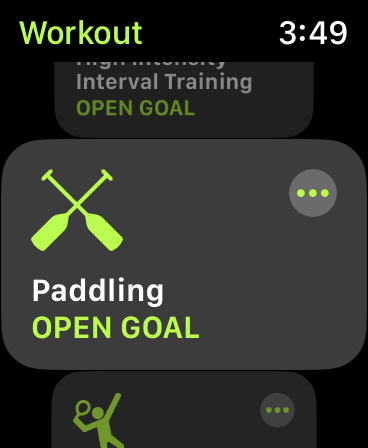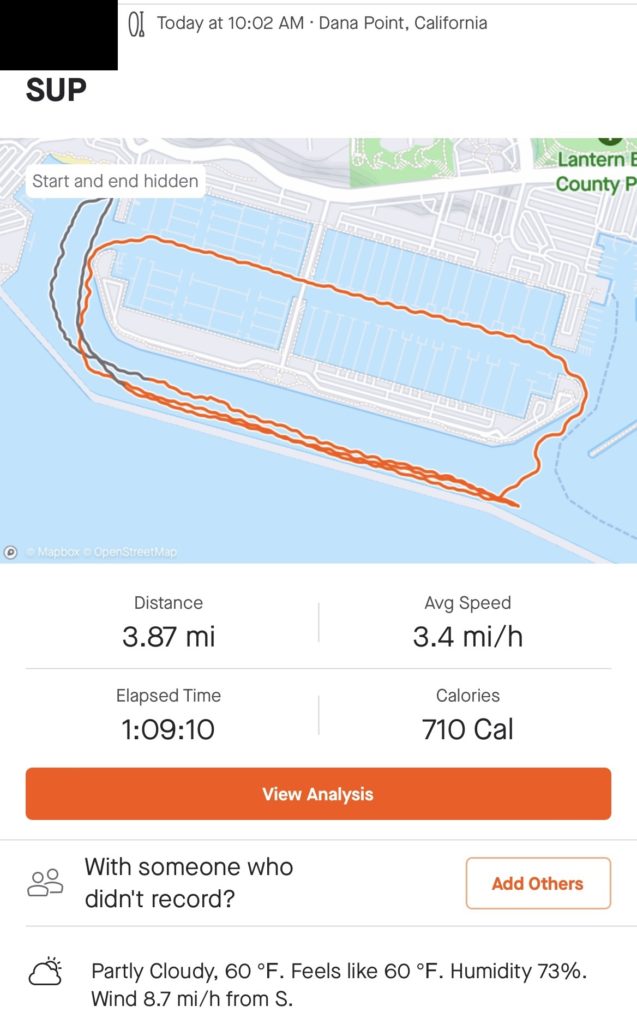Paddle boarding is not only a all around fun activity, it is also a great workout. It can be a great way to cross train, build core muscles, and experience the water in a whole new way.
Of course we look paddling and wondered how to track a Paddle Boarding workout or stand up paddling boarding (SUP). So we tried out a Stand Up Paddle boarding session with an Apple Watch. It is worth noting that paddling boarding and stand up paddle boarding are effectively the same thing when it comes to tracking.

The Apple Watch offers a workout type for paddling. Unfortunately this is not the best way to track, and you won’t realize that until after the workout. Even though the name matches the activity, the stats are lacking.
Similar to indoor treadmill or other workouts, the paddling option does not include GPS data. Instead it tracks for time and calories burned. While this counts towards closing your rings, it will lack some data that many users want. Below is a table of the options for how to track paddling on Apple Watch.
| Paddle Tracking | Pros | Cons |
|---|---|---|
| Apple Paddling Activity | Easy to use and start. Has calorie data. Free. | No GPS data, no weather data, no paddle specific data. |
| Apple “Run” Activity | Tracks GPS, tracks calories. Easy and free. | Need to export to another service to avoid messing up aggregated run data. |
| Custom App | Has Paddle specific data (strokes, speed). Tracks GPS. | Not Free. |
If you spend a great day out on the water and want to show off where you paddled, or how far you went, or even track paddling performance over time, you will need more than just the built in options. This article covers some of the things you should know when using an Apple Watch to track paddle boarding.
Getting Paddle Boarding and GPS Data
A lack of GPS data is not unique to the Apple Watch paddle activity. The same issue with GPS data occurs with Strava, which has a SUP option although it is not available on the default Strava watch app so it’s harder to make the mistake of using it then not having mapped data.
Since by default the SUP setting on Strava and the Paddle activity on Apple Watch do not track GPS data. This means that distance data and speed do not get tracked, and for more scenic paddles you will not get a cool map graphic showing your route. There is of course some ways around this.
Of course there are specialized tools for tracking paddle boarding, which is great news since it is an all around strong workout. This is the first tip, if you are looking to use your watch for Paddle Boarding consider using a custom app, not the built in workout, to get truly activity specific data.
If you do not want to pay for and find a custom paddle app though, the easiest way to get GPS data for Paddling is to simply record the activity as a run or other activity type. Start a Walk, Run, or Ride activity and complete it as you would a normal one.
Once it has finished and uploaded into the app you can go in and edit the activity. This is the same thing you do to alter the name, add comments, or add photos, but instead just swap the activity type to “Stand Up Paddle” and it will be recorded as such. We do this both in the Apple Watch app and in the native Strava app.

Thankfully it is rare that you produce a best mile time on a paddle board, unless you are going with the current, since it is comparatively slower than running. After editing the activity all this aggregated data goes away so it should not majorly impact your expected times, but will alter any aggregated data you have.
The only real risk is GPS glitches, which are more likely if you are paddling in a remote area and across water where you may not be getting accurate GPS points.
In popular areas though, marinas and bays near populated areas, the stats are surprisingly accurate. In the above workout you can even see the wiggling trail through the water that is caused by alternating sides of the board to paddle on.
How Many Calories Does Paddle Boarding Burn
From our activities it seems that most of the apps use some form of heart rate analysis to measure how many calories you burn. It is worth noting that this may be in accurate. In general our activities over an hour will show that Paddle Boarding burns less than running but more than cycling. An easy hour of each for a 200 lb man equates to:
Cycling (600 cal/hr) < (700 cal/hr) Paddle Boarding < (800 cal/hr) Running
On a perceived effort basis though paddle boarding often gets our heart rate higher than other activities at a similar effort level. That is to say, even a leisurely paddle seems to get the heart rate quickly above a standard walk.
Some of this calorie difference might be due to the increased stimulus of having to stay balanced and a slight fear of falling into the mouth of some sea-life, but even then it is still a good way to get the blood flowing.
Using SUP Specific Apps for Paddle Board Tracking
Since paddling is not as popular as other fitness activities (like cycling and running), when it comes to tracking the default options are a bit lacking.
Having an activity specific app is super helpful for this, as it is for other less common tracked activities like jumping rope or playing tennis with an Apple Watch. For paddling there are a handful of features that are nice to have and offered on some of the more popular apps.
Paddle Feature – GPS Tracking, Distance, and Path Tracking for SUP Workouts
GPS tracking is one of the most fun and useful added features to track. Especially on lakes or inlets where finding out where you went after the fact is helpful, having the direct path for historical records is wonderful. It is also nice to get a sense of how far off shore you might have been, or see how the wind pushes you off a straight line.
The other addition that GPS tracking has is that it allows for distance and speed to be populated in the apps. Again it’s possible to find out how wind and current effect your pace, which can be useful if you are using the data to plan longer outings.
While we prefer Paddle Logger, the features to consider for a paddling app are mostly laid out below.
Paddle Feature -Safety Notifications with Open Water Workouts
Open water activity comes with inherent risks. Many SUP rental places will require personal floating devices (handy inflatable belts or vests) just as a way to reduce liability. For first timers, and even advanced paddlers, there is also always the risk of not being able to get back.
With wind, currents, or potential injury there is a true risk of being caught on a board unable to get back. This is highlighted in one Apple Watch promo video, with a paddler placing a call from their watch to an emergency line that connects to a coastguard, but other apps also offer the option to broadcast a location beacon or automatically send alerts if you do not check in.
Paddle Feature – Heart Rate While Stand Up Paddle Boarding
Heart rate data is important for any sport, especially endurance ones where staying in a reasonable hert rate zone can help prolong the amount of time you can maintain an effort.
Spiking into high heart rates for any activity can overload the body with lactic acid and make it hard to keep going, which is especially problematic if the return trip is into the wind or current. Tracking using any variation of app that has an apple watch integration will capture this data, while using an iPhone or Android tracker on a smart phone will leaving you wanting.
In a one hour session, going at a reasonable pace, I have been able to get my heart rate to 85%-90% of max while stand up paddle boarding, typically while powering across minor swells. Keeping balance engages the legs, and paddling engages the rest of the body so it is possible to really pump the heart rate up.
Paddle Specific Tracking Apps for Apple Watch
If the Apple Watch SUP options are not enough for you (and they likely are not), there are others to take a look at for more serious stand up paddle boarders:
Paddle Logger – This tracker offers all of the above relevant data, with a pro account. The basic account still gets you heart rate, GPS, and calories burned with a normal workout. This makes the free option better than the default Apple Watch, but only slightly.
If you want additional data, including top speeds, split times, or the ability to populate a workout with some photos you need to upgrade to the pro-option. There is a free 7-day trial but beyond that it will cost you $40 for an annual plan, without the ability to aggregate other activities into the single app this is a bit steep for a tracker.
I think they updated the SUP workout on Strava to include GPS.
If I start the activity in the strava app on my apple watch – it also tracks heart rate.